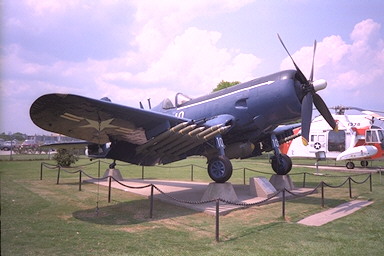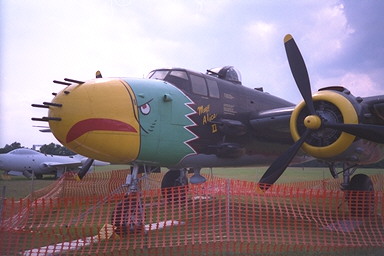
The Corsair was developed for the Navy as a replacement for the
obsolescent Grumman F4F Wildcat fighter. The Wildcat was slower at climbing
than the Japanese Zero fighter and much less manueverable. The F4F-4 had the
advantage of self-sealing fuel tanks and pilot armor, but was even worse
at manuevering. The F4U was a much faster aircraft with a longer range
than the F4F or the Zero.

Unfortunately, the F4U was not quite what the US Navy had in mind. US Navy pilots had acheived a 1-1 kill ratio with the Japanese Zero by superior deflection shooting, i.e. they could hit a target without having to get on its tail. The Corsair with its long nose and partially recessed cockpit (compared to the Wildcat), was not well-suited for deflection shooting. Even worse for the Navy, the long nose of the Corsair made it very difficult to land onboard a carrier. This fault nearly consigned one of the best carrier fighters of World War II to land base only use. It was good at it--witness the exploits of the Black Sheep (USMC) and Jolly Rogers (USN) Squadrons during the Solomons Campaign, but it could do more.
The Corsair's redemption came at the hands of the British, oddly enough. They were in even more desperate need for good carrier fighters than the US was, and to use the Corsair they developed a different landing pattern around the carrier. The final approach was curved to allow the pilot to see past the nose of the F4U. The USN latched onto the innovation at a crucial time. The Japanese kamikaze attacks had demonstrated the need for even more fighters on carriers. The regular F6F Hellcat squadrons needed help, and the F4U was perfect for the job. It could replace the troublesome SB2C Helldiver in the attack role while keeping the speed to run down incoming kamikazes. And when the war ended at the dawn of the jet age, the F4U was kept on board as an attack aircraft.
The Corsair soldiered on into the Korean War as a light attack aircraft. Ending finally when it was replaced by the A-1 "Spad".

The second claim to fame for the B-25 was the Battle of the Bismarck Sea. In this battle, B-25s along with British Beaufighters, US A-20s, B-17s, and P-38s destroyed a Japanese troop convoy headed to New Guinea. They sunk eight of eight troop transports and four of eight destroyers. This is the first time air power alone completely destroyed a convoy. Part of the reason for the success of this battle was the carefully coordinated attack plan. Beaufighters came in with their 20mm cannons to strafe, followed by A-20s, and then the Mitchells with a combined strafing and skipbombing attack. The B-17s came in high protected by the P-38s, distracting the escorting Zero fighters and the destroyers heavy anti-aircraft fire.
|
|
The A-12 was built by Lockheed for the CIA as a long-range, high-speed, high-altitude reconnaissance aircraft. The CIA wanted an aircraft to replace the U-2 spy aircraft. The design proved successful enough that it was updated to include a second crewman, and lengthened for additional fuel capacity to become the SR-71. Other designs that sprang from the A-12 were the M-12/D-21 mothership/drone combination and the YF-12. The latter would have been the highest and fastest interceptor ever built. It would have carried two or three Phoenix missiles--the same carried by the F-14 Tomcat. |
Question, comments, suggestions?
Mail them to me, David Benjamin, at
benjadp at yahoo.com
Last modified on: Wednesday, 19-Mar-2003 13:59:51 CST